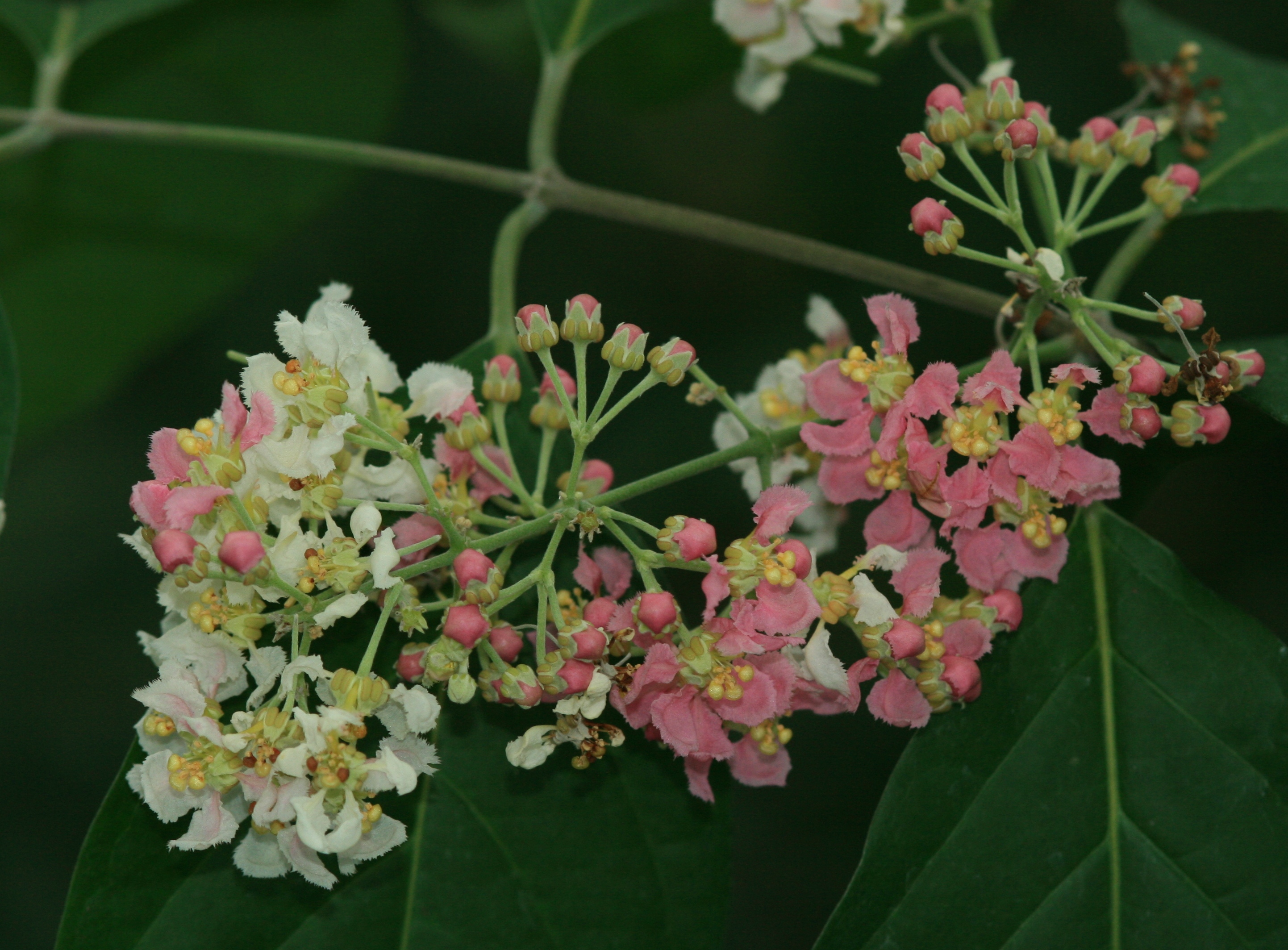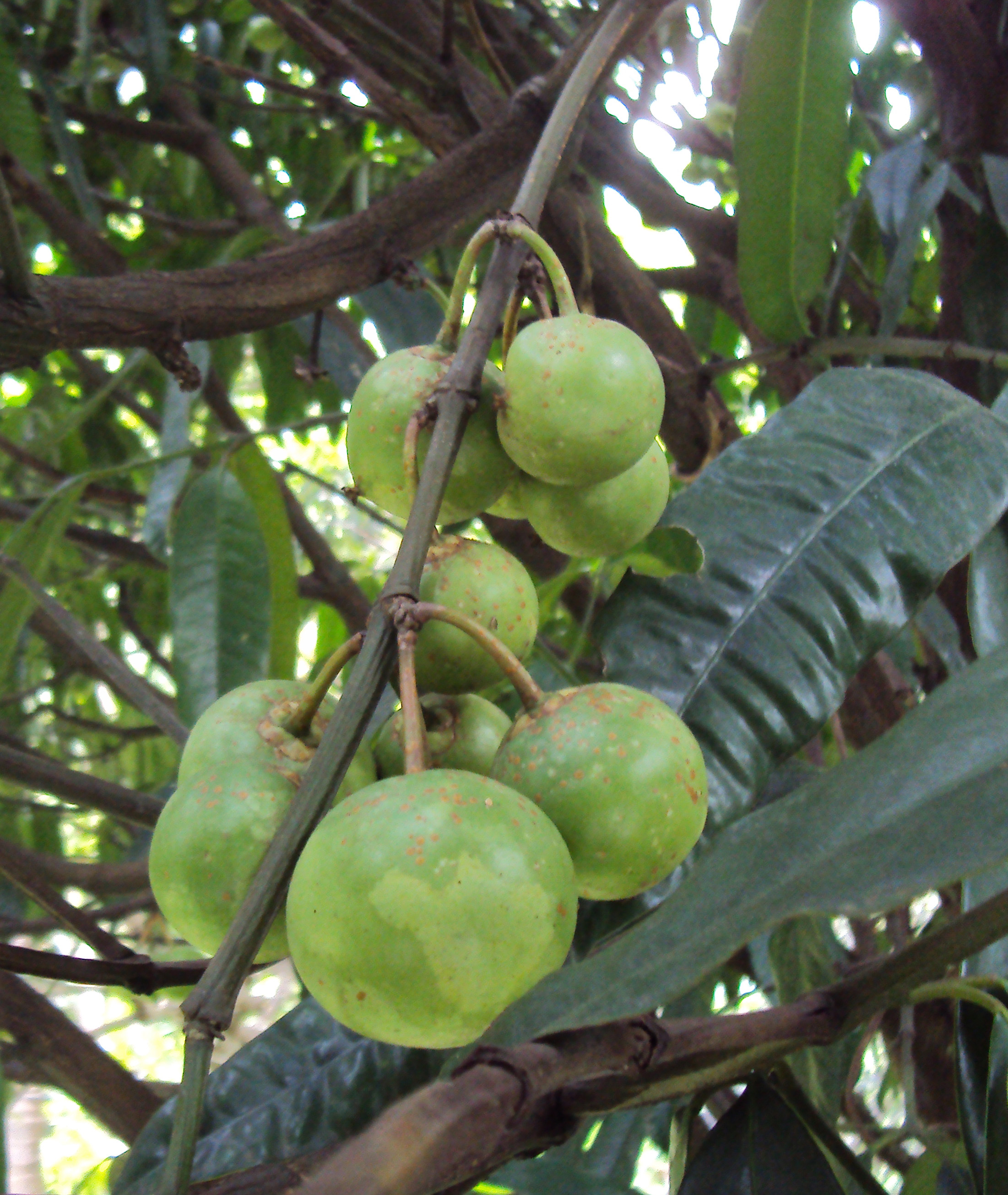|
Malpighiaceae
Malpighiaceae is a family of flowering plants in the order Malpighiales. It comprises about 73 genera and 1315 species, all of which are native to the tropics and subtropics. About 80% of the genera and 90% of the species occur in the New World (the Caribbean and the southernmost United States to Argentina) and the rest in the Old World (Africa, Madagascar, and Indomalaya to New Caledonia and the Philippines). One useful species in the family is '' Malpighia emarginata'', often called acerola. The fruit is consumed in areas where the plant is native. The plant is cultivated elsewhere for the fruit, which is rich in vitamin C. Another member of the family, caapi or yagé (''Banisteriopsis caapi''), is used in the entheogenic brew known as ayahuasca. One feature found in several members of this family, and rarely in others, is providing pollinators with rewards other than pollen or nectar; this is commonly in the form of nutrient oils (resins are offered by Clusiaceae). Genera * ... [...More Info...] [...Related Items...] OR: [Wikipedia] [Google] [Baidu] |
Acmanthera
''Acmanthera'' is a genus in the Malpighiaceae, a family of about 75 genera of flowering plants in the order Malpighiales. ''Acmanthera'' comprises 7 species of trees, shrubs, or subshrubs native to Brazil Brazil ( pt, Brasil; ), officially the Federative Republic of Brazil (Portuguese: ), is the largest country in both South America and Latin America. At and with over 217 million people, Brazil is the world's fifth-largest country by area .... References *Anderson, W. R. 1975. The taxonomy of ''Acmanthera'' (Malpighiaceae). Contributions from the University of Michigan Herbarium 11: 41–50. *Anderson, W. R. 1981 1980" A new species of ''Acmanthera'' (Malpighiaceae). Systematic Botany 5: 438–441. External linksMalpighiaceaeMalpighiaceae - description, taxonomy, phylogeny, and nomenclature Malpighiaceae Malpighiaceae genera {{Malpighiaceae-stub ... [...More Info...] [...Related Items...] OR: [Wikipedia] [Google] [Baidu] |
Alicia (plant)
''Alicia'' is a genus in the Malpighiaceae, a family of about 75 genera of flowering plants in the order Malpighiales. ''Alicia'' comprises 2 species of woody vines widespread in South America. It is named after the Argentine-French botanist Alicia Lourteig Alicia Lourteig (1913–2003) was an Argentine and French botanist, world specialist in Oxalidaceae. Personal life and education Alicia Lourteig was born in Buenos Aires, Argentina. Her parents originated from France and Argentina. She studied .... External links and references MalpighiaceaeMalpighiaceae - description, taxonomy, phylogeny, and nomenclature*Anderson, W. R. 2006. Eight segregates from the neotropical genus ''Mascagnia'' (Malpighiaceae). Novon 16: 168–204. Malpighiaceae Malpighiaceae genera {{Malpighiaceae-stub ... [...More Info...] [...Related Items...] OR: [Wikipedia] [Google] [Baidu] |
Malpighiales
The Malpighiales comprise one of the largest orders of flowering plants, containing about 36 families and more than species, about 7.8% of the eudicots. The order is very diverse, containing plants as different as the willow, violet, poinsettia, manchineel, rafflesia and coca plant, and are hard to recognize except with molecular phylogenetic evidence. It is not part of any of the classification systems based only on plant morphology. Molecular clock calculations estimate the origin of stem group Malpighiales at around 100 million years ago ( Mya) and the origin of crown group Malpighiales at about 90 Mya. The Malpighiales are divided into 32 to 42 families, depending upon which clades in the order are given the taxonomic rank of family. In the APG III system, 35 families were recognized. Medusagynaceae, Quiinaceae, Peraceae, Malesherbiaceae, Turneraceae, Samydaceae, and Scyphostegiaceae were consolidated into other families. The largest family, by far, is the Euphorbiaceae, ... [...More Info...] [...Related Items...] OR: [Wikipedia] [Google] [Baidu] |
Adelphia (plant)
''Adelphia'' is a genus in the Malpighiaceae, a family of about 75 genera of flowering plants in the order Malpighiales. ''Adelphia'' comprises four species of woody vines native to the West Indies, Mesoamerica, and western South America South America is a continent entirely in the Western Hemisphere and mostly in the Southern Hemisphere, with a relatively small portion in the Northern Hemisphere at the northern tip of the continent. It can also be described as the southe .... External links and references MalpighiaceaeMalpighiaceae - description, taxonomy, phylogeny, and nomenclature*Anderson, W. R. 2006. Eight segregates from the neotropical genus ''Mascagnia'' (Malpighiaceae). Novon 16: 168–204. Malpighiaceae Malpighiaceae genera {{Malpighiaceae-stub ... [...More Info...] [...Related Items...] OR: [Wikipedia] [Google] [Baidu] |
Galphimia Gracilis
''Galphimia gracilis'', a species in the genus '' Galphimia'' of the family Malpighiaceae, is native to eastern Mexico. It is widely cultivated in warm regions throughout the world, often under the common names gold shower or shower-of-gold, slender goldshower or sometimes thryallis. In horticultural publications, in the nursery trade, and on websites, this species is commonly but mistakenly referred to as '' Galphimia glauca'', '' Galphimia brasiliensis'', ''Thryallis glauca'', ''Thryallis gracilis'', or often in South America, ''Thryallis brasiliensis''. ''Galphimia gracilis'' is easily told apart from the true ''G. glauca'' and ''G. brasiliensis'' by the flowers. In ''G. gracilis'' the petals fall as the fruit matures; in ''G. glauca'' the petals are persistent even in fruit. In ''G. gracilis'' many flowers of a dense inflorescence An inflorescence is a group or cluster of flowers arranged on a Plant stem, stem that is composed of a main branch or a complicated arrangem ... [...More Info...] [...Related Items...] OR: [Wikipedia] [Google] [Baidu] |
Acridocarpus
''Acridocarpus'' (from Gr. ''Akris'', a locust and ''carpos'', a fruit, alluding to the winged fruit) is a genus of plant in family Malpighiaceae. They are native to Arabia and tropical and subtropical Africa, with one species in New Caledonia. Species There are some 30 species, which include: * '' Acridocarpus austrocaledonicus'' * '' Acridocarpus chevalieri'' * '' Acridocarpus monodii'' Arènes & P.Jaeger ex Birnbaum & J.Florence * ''Acridocarpus orientalis'' (Jebel Hafeet, UAE / Oman Oman ( ; ar, عُمَان ' ), officially the Sultanate of Oman ( ar, سلْطنةُ عُمان ), is an Arabian country located in southwestern Asia. It is situated on the southeastern coast of the Arabian Peninsula, and spans the mouth of ...) * '' Acridocarpus natalitius'' Adr. & Juss. * '' Acridocarpus socotranus'' Oliv. References External links * Malpighiaceae Malpighiaceae genera Taxonomy articles created by Polbot {{Malpighiaceae-stub ... [...More Info...] [...Related Items...] OR: [Wikipedia] [Google] [Baidu] |
Malpighia Emarginata
''Malpighia emarginata'' is a tropical fruit-bearing shrub or small tree in the family Malpighiaceae. Common names include acerola cherry, Guarani cherry, Barbados cherry, West Indian cherry, and wild crepe myrtle. Acerola is native to Paraguay and Brazil in South America, Central America and southern Mexico, Puerto Rico, Dominican Republic and Haiti, but is now also being grown as far north as Texas and in subtropical areas of Asia, such as India. Distribution ''Malpighia emarginata'' is originally from Yucatán, and can be found in Mexico, Central America, the Caribbean, South America as far south as Peru and Colombia, and the southeast region of Brazil, and in the southernmost parts of the contiguous United States (southern Florida and the Lower Rio Grande Valley of Texas). In Florida, it can be grown in protected locations as far north as Cape Canaveral. It is cultivated in the tropics and subtropics throughout the world, including the Canary Islands, Ghana, Ethi ... [...More Info...] [...Related Items...] OR: [Wikipedia] [Google] [Baidu] |
Banisteriopsis Caapi
''Banisteriopsis caapi'', also known as ayahuasca, caapi, soul vine, or yagé (yage), is a South American liana of the family Malpighiaceae. It is one half of ayahuasca, a decoction with a long history of its entheogenic (connecting to spirit) use and its status as a "plant teacher" among the Indigenous peoples of the Amazon rainforest. According to ''The CRC World Dictionary of Plant Names'' by Umberto Quattrocchi, the naming of the genus '' Banisteriopsis'' was dedicated to John Banister, a 17th-century English clergyman and naturalist. An earlier name for the genus was ''Banisteria'' and the plant is sometimes referred to as ''Banisteria caapi''. Other names include ''Banisteria quitensis'', ''Banisteriopsis inebrians'', and ''Banisteriopsis quitensis''. Description Caapi is a giant vine with characteristic white or pale pink flowers which most commonly appear in January, but are known to bloom infrequently. It resembles ''Banisteriopsis membranifolia'' and '' Banisteriopsis ... [...More Info...] [...Related Items...] OR: [Wikipedia] [Google] [Baidu] |
Clusiaceae
The Clusiaceae or Guttiferae Juss. (1789) (''nom. alt. et cons.'' = alternative and valid name) are a family of plants including 13 genera and ca 750 species. Several former members of Clusiacae are now placed in Calophyllaceae and Hypericaceae. They are mostly trees and shrubs, with milky sap and fruits or capsules for seeds. The family is primarily tropical. More so than many plant families, it shows large variation in plant morphology (for example, three to 10, fused or unfused petals, and many other traits). According to the APG III, this family belongs to the order Malpighiales. One feature which is sometimes found in this family, and rarely in others (e.g., Malpighiaceae), is providing pollinators with rewards other than pollen or nectar; specifically, some species offer resin which bees use in nest construction (all three rewards are found in different species of the Clusiaceae). Taxonomic history The family Clusiaceae was divided by Cronquist into two subfamilies: ... [...More Info...] [...Related Items...] OR: [Wikipedia] [Google] [Baidu] |
Flowering Plant
Flowering plants are plants that bear flowers and fruits, and form the clade Angiospermae (), commonly called angiosperms. The term "angiosperm" is derived from the Greek words ('container, vessel') and ('seed'), and refers to those plants that produce their seeds enclosed within a fruit. They are by far the most diverse group of land plants with 64 orders, 416 families, approximately 13,000 known genera and 300,000 known species. Angiosperms were formerly called Magnoliophyta (). Like gymnosperms, angiosperms are seed-producing plants. They are distinguished from gymnosperms by characteristics including flowers, endosperm within their seeds, and the production of fruits that contain the seeds. The ancestors of flowering plants diverged from the common ancestor of all living gymnosperms before the end of the Carboniferous, over 300 million years ago. The closest fossil relatives of flowering plants are uncertain and contentious. The earliest angiosperm fossils ar ... [...More Info...] [...Related Items...] OR: [Wikipedia] [Google] [Baidu] |
Genus
Genus ( plural genera ) is a taxonomic rank used in the biological classification of extant taxon, living and fossil organisms as well as Virus classification#ICTV classification, viruses. In the hierarchy of biological classification, genus comes above species and below family (taxonomy), family. In binomial nomenclature, the genus name forms the first part of the binomial species name for each species within the genus. :E.g. ''Panthera leo'' (lion) and ''Panthera onca'' (jaguar) are two species within the genus ''Panthera''. ''Panthera'' is a genus within the family Felidae. The composition of a genus is determined by taxonomy (biology), taxonomists. The standards for genus classification are not strictly codified, so different authorities often produce different classifications for genera. There are some general practices used, however, including the idea that a newly defined genus should fulfill these three criteria to be descriptively useful: # monophyly – all descendants ... [...More Info...] [...Related Items...] OR: [Wikipedia] [Google] [Baidu] |
Family (biology)
Family ( la, familia, plural ') is one of the eight major hierarchical taxonomic ranks in Linnaean taxonomy. It is classified between order and genus. A family may be divided into subfamilies, which are intermediate ranks between the ranks of family and genus. The official family names are Latin in origin; however, popular names are often used: for example, walnut trees and hickory trees belong to the family Juglandaceae, but that family is commonly referred to as the "walnut family". What belongs to a family—or if a described family should be recognized at all—are proposed and determined by practicing taxonomists. There are no hard rules for describing or recognizing a family, but in plants, they can be characterized on the basis of both vegetative and reproductive features of plant species. Taxonomists often take different positions about descriptions, and there may be no broad consensus across the scientific community for some time. The publishing of new data and opini ... [...More Info...] [...Related Items...] OR: [Wikipedia] [Google] [Baidu] |

_in_Hyderabad%2C_AP_W_IMG_7704.jpg)
.jpg)


